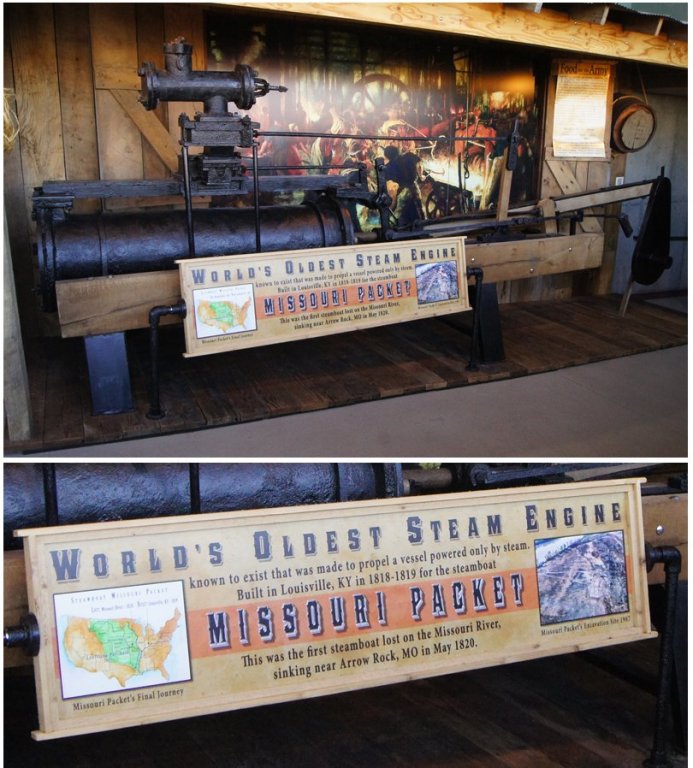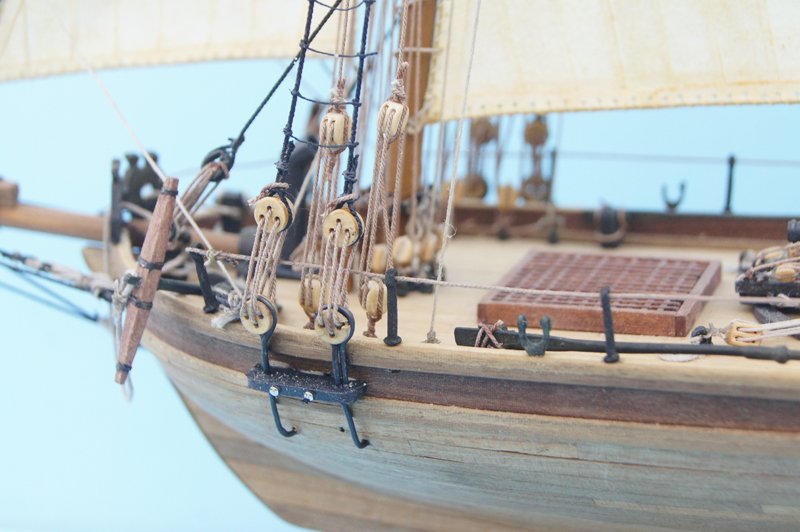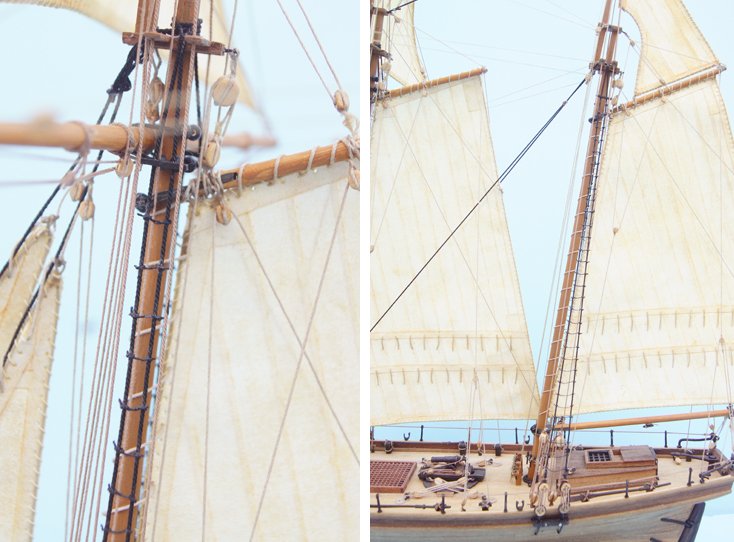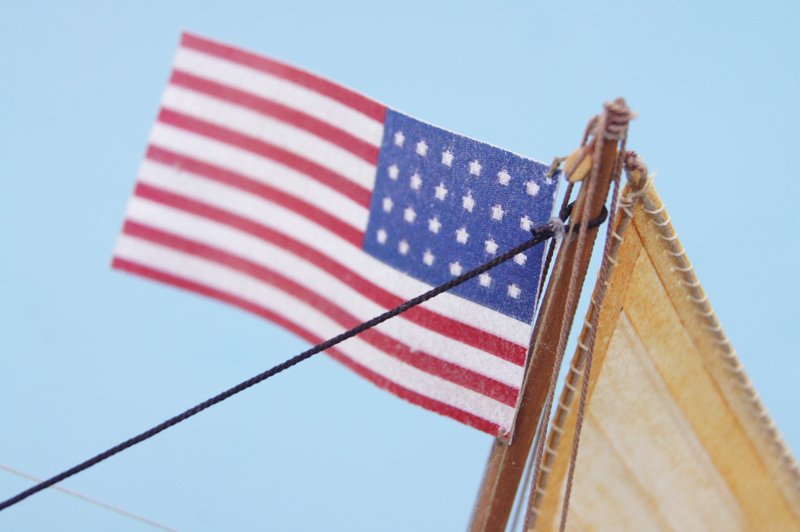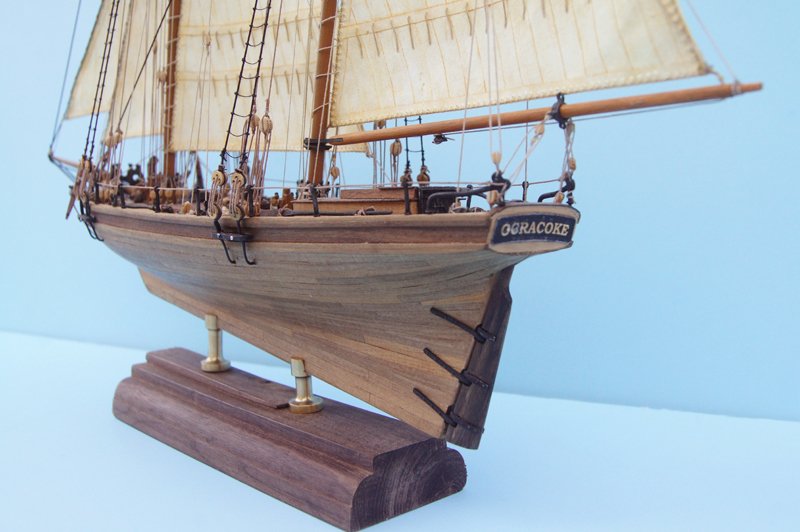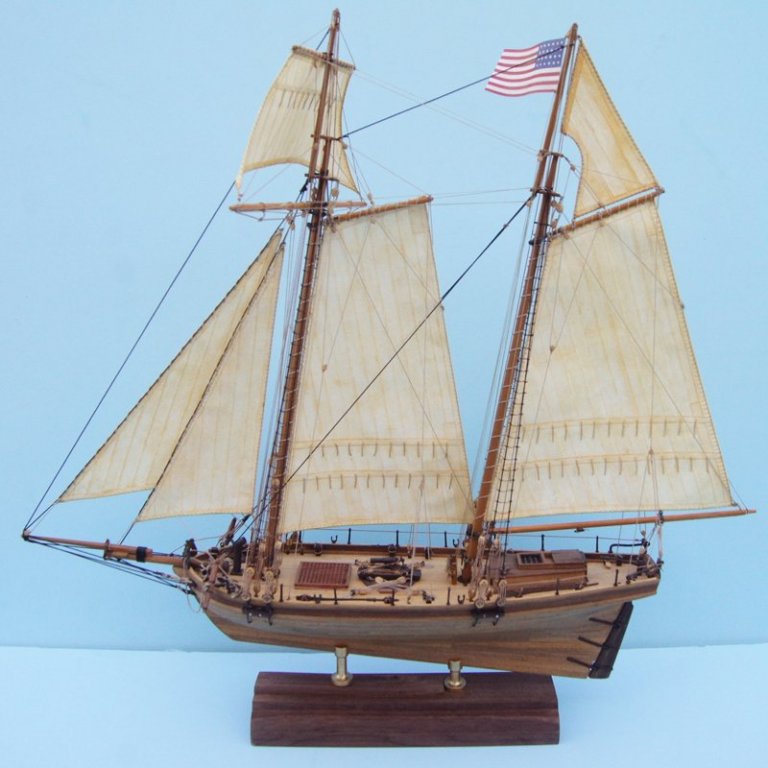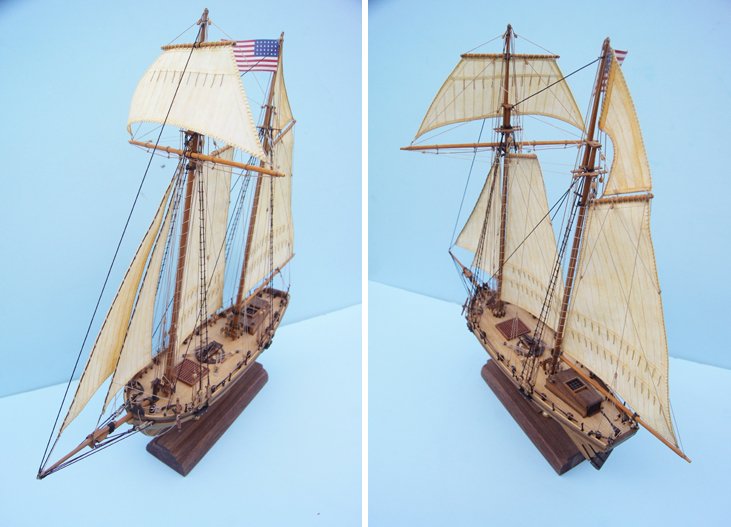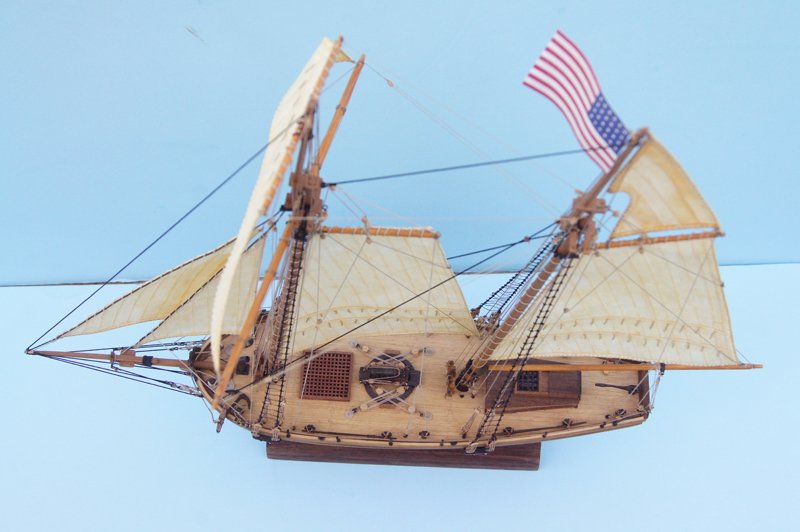-
Posts
3,502 -
Joined
-
Last visited
Content Type
Profiles
Forums
Gallery
Events
Everything posted by Cathead
-
If I understand your question correctly, you're asking why the ropes descend through the deck? Anchor cables weren't stored on the winch, there would be way too much cable to fit on there. The machinery is only used to help raise the cables and pass them down to their actual storage location, coiled in the hold.
-
I just discovered this build, and it's lovely. I can't wait to follow it through to completion. Your sails are quite nice.
- 144 replies
-
- surprise
- artesania latina
-
(and 2 more)
Tagged with:
-
Thanks, Gregory, though I have to say I wouldn't recommend this particular kit. HMS Pickle from Caldercraft or the Revenue Cutter from Bluejacket are similar craft and from much better manufacturers. But, hey, it's certainly possible to do a decent job with the Corel kit with patience and cursing, so have at it if you prefer and good luck! Start a log, there are very few completed builds for this kit and your experiences could help others, too.
- 96 replies
-
- topsail schooner
- revenue cutter
-
(and 3 more)
Tagged with:
-
I agree about the brightness, but the overall effect is still lovely. The window curtains are a nice touch.
- 69 replies
-
- city of monroe
- steamboat
-
(and 1 more)
Tagged with:
-

Steamboats and other rivercraft - general discussion
Cathead replied to Cathead's topic in Nautical/Naval History
I recently visited the Steamboat Arabia Museum in Kansas City, Missouri (USA) to take photographs and measurements for my next model project, the Missouri River steamboat Arabia. If you want to read about that project, I'm documenting my research and resources in this thread. However, I wanted to share this non-Arabia feature of the museum: I blew up the sign, but if you still can't read it, it says "World's Oldest Steam Engine known to exist that was made to propel a vessel powered only by steam. Built in Louisville, KY in 1818-1819 for the steamboat Missouri Packet. This was the first steamboat lost on the Missouri River, sinking near Arrow Rock, MO in May 1820." I thought this would be of interest to many of you. Arrow Rock is not far from my farm in central Missouri and is the site of a really lovely Missouri state historic site preserving an early river town.- 281 replies
-
- Steamboats
- riverboats
-
(and 3 more)
Tagged with:
-

Totally-wet-behind-the-ears-noob question
Cathead replied to jpooch01's topic in Wood ship model kits
John, you might check out this thread from elsewhere on MSW, which has an active discussion about the paints from Model Shipways (Model Expo). -
The model is done. I made some executive decisions about the standing rigging and just worked through them. I didn't take any photos during the rest of the work, partly because I was ready to be done with this project and just wanted to keep working without setting up special photo sessions, and partly because I didn't think I was doing anything that hadn't been documented a number of times before. For example, I did the ratlines and deadeyes by making a wire spacer for the deadeyes and tying the ratlines using a lined wooden guide, but those approaches have been better described by others. Also, as some of you may have read in the news, it's been extraordinarily wet here in Missouri with devastating rain and flooding, and that's meant very poor photography conditions (dark indoors and wet outdoors). The model has been done for a week, but I finally found time and conditions to take some photos outdoors. I used a blue background to try and emphasize the reddish colors in the model; the white background I tried first washed out the colors too much. Example of the standing rigging. I settled on two sets of shrouds and topmast stays per mast per side. I think they came out ok. You can also see the sweeps lashed to their stanchions and the safety lines, or whatever they were called in the early 1800s. I need to repaint the nailheads holding the channels in, I rubbed the original paint off handling the model. Examples of ratlines and shrouds. I carved and painted a small spacer for each set of shrouds and inserted it about a man's height from the tops. This seems to produce a sensible pattern to the ratlines. I tied the latter using an overhand knot, which I realize is less accurate than a knot that turns each end inward (as opposed to outward) but I spent a whole evening trying to master the "right" approach and couldn't. Few viewers around here will recognize that the tips of the ratlines shouldn't be outside the stays. Otherwise I think they turned out ok. I made a flag by laying out back-to-back flags on the computer and printing them on the same bond paper as the sails. I then brushed wood glue on the backside and folded them over. The effect has a nice, rough, cloth-like look that's far better than shiny plastic and holds its shape better than cloth (just like the sails). I rejected the flag from the kit not only because it was shiny, but because based on my research its design had never been used in US history (wrong number and pattern of stars). I chose a 24-star flag, which was used from 1822-1836, about the right time period for this post-War-of-1812 revenue cutter. It also happens to be the flag that represents my state of Missouri (the 24th state), a nice touch. As the last step, I made a base from a chunk of Black Walnut harvested on our farm, which I chain-saw milled to rough size and then cut down using a table saw and router. The pedestals are from Model Expo. I also made a nameplate for the stern, again designed on computer and printed on bond paper, then glued to the stern. A bit of ink rubbed off in this process, but I think it just looks nicely scuffed and weathered. The name has a specific meaning for me. Many of the revenue cutters from this period were named for their region of intended service; for example the Louisiana and Alabama, the closest prototypes to this vessel, served in the Gulf of Mexico. My family has a long, multi-general history of visiting North Carolina's Outer Banks, a fascinating set of thin, sandy barrier islands that have been the scene for many important bits of American naval history, including a great deal of smuggling and piracy. It's one of my favorite pieces of coastline in the world. Thus, I named this vessel Ocracoke after the most significant harbor in the Outer Banks, a town with many fond memories and associations to me. I don't think any such cutter was ever based there, but in the fictional world of this model, there most certainly was. With those steps completed, I declared the model done. I have mixed feelings about this project. I found the kit very frustrating, with terrible instructions and mediocre quality materials. Yet I also learned a great deal from working through those problems, and am really very happy with how the model turned out. It has lots of small errors or problems that an expert or contest judge would instantly notice, but I also think it came together in a very aesthetically pleasing way, and I can justify/explain every bit of rigging and equipment on it whether or not it's strictly prototypical (for example, I made sure the flag hoist would really work). So here are a few completed photos. I'm not entirely happy with the color balance, but do like how the blue background sets off the model. Thank you to everyone/anyone who's followed this somewhat disjointed build log. I've appreciated your interest and support. I've already started planning my next project, another scratchbuilt Missouri River steamboat, and will be building a Maine lobster boat for my mother to keep my hands busy during the extensive design period for the former.
- 96 replies
-
- topsail schooner
- revenue cutter
-
(and 3 more)
Tagged with:
-
Oh, the wheels would have been washed plenty clean by their inherent action, and technically many of the outhouses weren't dropping directly onto the buckets, just into the zone where the wheel's downward motion helped disperse the material. Probably cleaner than the bows of some sailing vessels. Although I recall a possibly apocryphal story of some crew doing repairs on a sternwheel while having someone else standing guard outside the ladies' hut to ensure that the workmen vacated the premises before any lady had to use the loo to avoid any, well, upward glances. I do suspect you're right that, if the model shows the shed being completely solid, it's not quite accurate: there should be some ventilation and light allowed in, at the eaves at least.
- 63 replies
-
- chaperon
- model shipways
-
(and 1 more)
Tagged with:
-

Totally-wet-behind-the-ears-noob question
Cathead replied to jpooch01's topic in Wood ship model kits
Welcome! I haven't built that kit, but you're very wise to start small and basic to learn the skills and whether you really like the hobby enough to tackle something bigger. The MS Bounty launch was my first time wooden kit, a similar craft, and it taught me loads of skill and perspective. Good luck. -
Kurt has built (and thoroughly researched) this model, so he's the final authority on its specifics. But a chicken coop would be a completely normal feature of a steamboat. Also, to my eye, that structure looks too small for regular human use (especially in original photos of Chaperon), and its placement isn't right for an outhouse. Its location would drop straight into the after cabin; these boats didn't have complicated plumbing. The actual outhouses are likely within the superstructure on the boiler deck, overhanging the paddle wheel (which does a good job of disposal). I don't think any boats would have made passengers climb to the hurricane deck to use the outhouse, and there would at the very least be two of them (gents and ladies). All of which confirms that it's a chicken coop.
- 63 replies
-
- chaperon
- model shipways
-
(and 1 more)
Tagged with:
-
I assume that, as in maritime vessels, a supply of fresh eggs would be highly desirable. Even on a settled river, having your own is better than buying them, and the hens can be fed in part from table scraps. Your Chaperon looks good so far.
- 63 replies
-
- chaperon
- model shipways
-
(and 1 more)
Tagged with:
-
Thanks, Carl. Unfortunately I still can't see enough detail there to figure out just what's going on. But following your suggestion that the topgallant shrouds could be a model, I went and looked at the detailed instructions for Syren, which still uses a small spreader bar (that's probably not the right term) between the shrouds. The problem is still that every other model I look at uses more than two shrouds per mast, spread over a wide base, meaning that the total width is wider and so it's easier to get higher and closer to the tops before the whole things gets too narrow. I finally found some images of the modern HMS Pickle, such as here or here, which only has three shrouds rising from a fairly narrow base. I think I'm going to call modeller's license, assume the caption had some leeway in the rigging of my fictional vessel, and install a small spreader between the two shrouds and then a couple of stays rising up to the topmast spreaders. In Syren, these were simply tied in place rather than being rigged to any blocks, so I'll do the same here. As in various other choices on this model, whether or not it's "right", I'll at least be able to justify it based on some form of prototype practice.
- 96 replies
-
- topsail schooner
- revenue cutter
-
(and 3 more)
Tagged with:
-
So I fixed the rigging problem by cutting out the lines and re-rigging, simply slipping the new lines in under the rope coils. It's hardly visible. I'll take better photos later, but right now I'm struggling with another problem. I've made very good progress on the standing rigging and have begun to rig ratlines. What I can't figure out is, what happens near the top of the ratlines on a small craft like this? The shrouds narrow in so much that at some point it seems pointless to keep tying ratlines, but without them how could anyone finish climbing to the tops? Larger ships have a wider spread of shrouds, and often use a spreader bar and other shrouds up to the topmast spreaders, but I can't find any documentation on how this was handled on a small schooner like this one. I've looked at MS's Pride of Baltimore and BlueJacket's revenue cutter, but neither one actually has ratlines, so that doesn't help. Here's a photo of my ratlines underway; I stopped when it started to get to narrow, but that's still a long scale distance to the tops. How should I finish these off?
- 96 replies
-
- topsail schooner
- revenue cutter
-
(and 3 more)
Tagged with:
-
I made a major mistake, and have not yet decided how best to fix it. Before that, though here's the good progress I've made. Apologies for the slightly fuzzy images; it's really windy outside today and I don't want to take outdoor photos. All sails attached, running rigging complete (the clothespins are holding a test of some standing rigging alignment): I decided to display the foretopsail at a sharp angle, both because this model will be viewed primarily from the side (thus making this sail more visible), and because it fits the overall layout of appearing as if the wind is coming from the rear port quarter. I like how the footropes look on the lower yard: Some detail of the running rigging along the masts and pin racks (again, sorry for the image quality): I've also made my final decision on the standing rigging. I'm going with (per mast, per side) two topmast shrouds, run through spreaders, and down to blocks and rings on the deck (I installed another ring near the mainmast to accommodate this), and two proper stays run down to two deadeyes, with ratlines for both masts. This meant I had to pull off the original channels and deadeyes I'd installed from the kit materials, as they were now in the wrong place and orientation, and come up with my own from scratch. I ordered deadeyes from Syren, which are wonderful, but coming up with a good scratchbuilt set of channels and so on was really hard for me. After much experimentation, I settled on the approach shown below, which isn't ideal but looks fine from a little distance (like most of the model). I realize they're not entirely accurate, but they're the best I've been able to come up with and I want to move on. Now for the mistake. Remember how I wanted to have the foretopsail displayed at a sharp angle, as if the wind were coming from the port quarter and so it would be move visible from the side? Well, turns out I overdid it. After gluing in all the lines and starting to test the setup of the standing rigging, I realized that I'd gone too far, and the yard was now behind where the running rigging would need to be. In the image below, compare the spreaders at the crosstrees and where the yard is: both the stays and shrouds would need to drop in front of the angled lower yard to reach their assigned positions on the deck. Oops. Fixing this won't be easy; all the lines holding the yard are already glued in, with rope coils glued on top. All I can think to do is cut those lines and try to discretely splice in some new line (on the starboard side) and reduce the line length (on the port side) to rotate the yard back to a shallow enough angle to allow the standing rigging to descend properly. That's not going to be easy, and any knots are really going to show. But the only other option I can think of is to leave the standing rigging off on this (non-display) side, which doesn't seem very acceptable. Any other good ideas?
- 96 replies
-
- topsail schooner
- revenue cutter
-
(and 3 more)
Tagged with:
-
That looks fantastic. The setting is nicely done, realistic and creative without distracting from the model itself. I've had fun following this one, you've done such a nice job.
- 165 replies
-
- finished
- model shipways
-
(and 1 more)
Tagged with:
-
Oh, that was in no way a criticism. In many ways not running the chimneys all the way through makes a lot of sense. I was just curious, especially as I'm starting to think about the design for my next one, and your progress has been inspiring and informative.
- 69 replies
-
- city of monroe
- steamboat
-
(and 1 more)
Tagged with:
-
Well, that's better than using Elm stain and naming your oldest son Minwax. He'd never forgive you. Model looks great so far.
- 75 replies
-
- model shipways
- picket boat
-
(and 1 more)
Tagged with:
-
Really looking nice, Clarence. It hadn't registered until now, but it looks like you're not running a single chimney through the decks but breaking it up on each deck?
- 69 replies
-
- city of monroe
- steamboat
-
(and 1 more)
Tagged with:
-
I'll happily repeat the accolades. Well done on a unique model.
- 296 replies
-
- chaperon
- model shipways
-
(and 1 more)
Tagged with:
-

Steamboats and other rivercraft - general discussion
Cathead replied to Cathead's topic in Nautical/Naval History
Interesting that the two initial sets of artwork depict masts, but the last one doesn't. The latter seems more likely to me; it also seems more realistic in terms of the overall layout of the vessel (such as placements of chimneys and boilers relative to the paddlewheels).- 281 replies
-
- Steamboats
- riverboats
-
(and 3 more)
Tagged with:
-

Steamboats and other rivercraft - general discussion
Cathead replied to Cathead's topic in Nautical/Naval History
Wish I could help. Those are some fantastic images. I grew up a few hours from there, but had never heard of this before. The figures leaping off the ship in the final photo are rather dramatic, if unlikely!- 281 replies
-
- Steamboats
- riverboats
-
(and 3 more)
Tagged with:
-
Glenn, what a useful response, thank you! The Corel image doesn't mean much; there's a lot about this kit that relies more on imagination than any real prototype practice, so I don't tend to follow their approach as "correct" in any given way, so just because they show that sail fully permanently rigged doesn't mean it was so. I had not considered that such a large sail could/would be taken down entirely, but it does help explain why so many such ships are shown without it even though it would be very useful when sailing downwind. I'm intrigued by the idea that it was only rigged with a block at each end of the yard; as you say, that could be modeled without the fuss of a furled sail but still acknowledging the existence and possibility of the sail. I will consider this, and thank you again!
- 96 replies
-
- topsail schooner
- revenue cutter
-
(and 3 more)
Tagged with:
-
Glenn, I'm happy to found this interesting and lovely build. You have some excellent detail work there, and the prototype is beautiful.
- 101 replies
-
- L Toile
- Billing Boats
-
(and 1 more)
Tagged with:
About us
Modelshipworld - Advancing Ship Modeling through Research
SSL Secured
Your security is important for us so this Website is SSL-Secured
NRG Mailing Address
Nautical Research Guild
237 South Lincoln Street
Westmont IL, 60559-1917
Model Ship World ® and the MSW logo are Registered Trademarks, and belong to the Nautical Research Guild (United States Patent and Trademark Office: No. 6,929,264 & No. 6,929,274, registered Dec. 20, 2022)
Helpful Links
About the NRG
If you enjoy building ship models that are historically accurate as well as beautiful, then The Nautical Research Guild (NRG) is just right for you.
The Guild is a non-profit educational organization whose mission is to “Advance Ship Modeling Through Research”. We provide support to our members in their efforts to raise the quality of their model ships.
The Nautical Research Guild has published our world-renowned quarterly magazine, The Nautical Research Journal, since 1955. The pages of the Journal are full of articles by accomplished ship modelers who show you how they create those exquisite details on their models, and by maritime historians who show you the correct details to build. The Journal is available in both print and digital editions. Go to the NRG web site (www.thenrg.org) to download a complimentary digital copy of the Journal. The NRG also publishes plan sets, books and compilations of back issues of the Journal and the former Ships in Scale and Model Ship Builder magazines.



